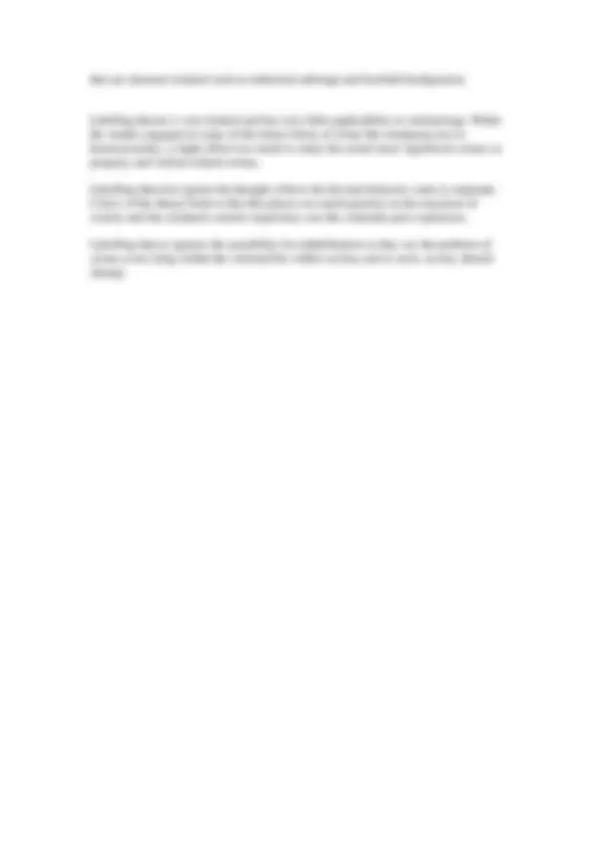



Study with the several resources on Docsity

Earn points by helping other students or get them with a premium plan


Prepare for your exams
Study with the several resources on Docsity

Earn points to download
Earn points by helping other students or get them with a premium plan
Community
Ask the community for help and clear up your study doubts
Discover the best universities in your country according to Docsity users
Free resources
Download our free guides on studying techniques, anxiety management strategies, and thesis advice from Docsity tutors
Labeling theory explores how society constructs and labels individuals as deviant, leading to self-fulfilling prophecies and deviant behaviors. Becker's article 'becker' (1963) discusses the objective nature of labels and their impact on social exclusion and secondary deviance.
What you will learn
Typology: Lecture notes
1 / 3

This page cannot be seen from the preview
Don't miss anything!


Labeling Theory
Labeling theory is based on social deviations that result in the labeling of the outsider. In his article Becker describes deviance as being created by society. Social groups create deviance through the establishment of social rules, the breaking of these rules results in the perpetrator being labeled as a deviant.
Because of the objectivity involved it is unnecessary to say that these labels are not always accurately applied to people. Once a label is given to an individual they become part of all the generalizations that go with that label. For instance, some one who has been convicted of a crime could be seen as someone who has no respect for the law. These labels also present a self fulfilling prophecy. Being identified as a deviant, a person is usually banished from conventional social groups, and therefore is forced to become part of less desirable ones. Being a member of less desirable social groups will only reinforce that they are a deviant, and increase their chances of engaging in deviant behaviors. The first time some one is labeled for deviant behavior, is known as the primary deviance, the secondary deviance is the deviant behavior that occurs after being labeled. Secondary deviance behaviors are reactions to effects of being labeled in the first place.
Development
Labeling theory or the social reaction theory was first proposed during the late 1950′s in opposition to normative theorists or the natural rights theories. Some of the people who contributed to it’s development were Howard Becker (1963), Tannenbaum (1951), and Lemert (1938). Lemert is considered as the first to actually introduce the ideal and Becker is the one who became the leader of the movement.
First of all is Lemert who did not consider himself to be a labeling theorist though he introduced primary and secondary deviance. Primary deviance is the behavior that causes the initial labeling of a person as a deviant. Once that label has been established deviant behaviors afterward are called secondary deviance. Secondary deviance happens when the person begins to identify with and classify himself or
herself by the label which society impressed upon them.
Then came Howard Becker who wrote the book Outsiders in 1963. The definition of labeling theory presented in his book became the generally accepted one. Becker stressed the need for a dynamic approach to the studying of labeling theory rather than a simple cause and effect one.
And finally Tannenbaum’s interpretation of labeling theory that was called the dramatization of evil. He thought that through the identification, and treatment of a deviant trait with in and individual (labeling) that trait was therefore emphasized causing it to become a larger and larger part of the deviant’s life.
William Cambliss conducted an important study in regards to labeling theory in 1973 in Chicago. In his study Cambliss identified highschool students who had a tendency to drink, steal, break curfews, and destroy property. He divided this group into two different groups and gave them the labels the “Saints” and the “Roughnecks”. The saints were boys who over all had decent grades, came from stable middle class house holds, and where careful about being caught by law enforcers. The “Roughnecks” were boys from lower class houses that were not as stable. They were more likely to be hostile in conflict with law enforcement and did not care in being caught. The boys in the “Roughneck” group were therefore labeled as deviants. The “saints”, even though they committed similar crimes, were not labeled because of they were polite to law enforcers when caught and they were from a higher social class. Eventually the police consistently and often took legal action when dealing with the “Roughnecks”. The “Saints” were treated far more softly where they never had legal actions taken against them.
Theory Strengths and Weakness:
The labeling theory Looks at all types of criminals in contrast with other theories that look at official criminal statistics and convicted criminal populations that don’t always reflect the true picture of real crime (crimes going unreported and such).
Unlike Labelling Theory, other theories of deviance set up the assumption that criminals are different from the normal population therefore it is possible to identify the feature that causes deviance. Yet it is challenging with the diverse range of acts